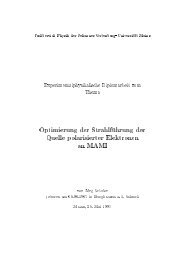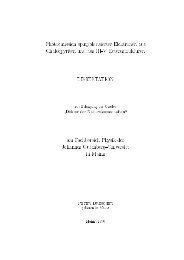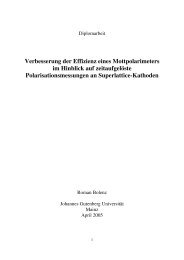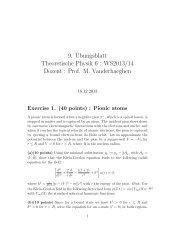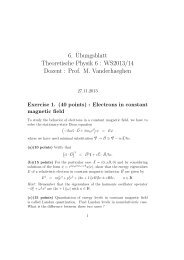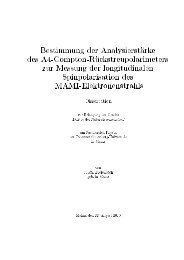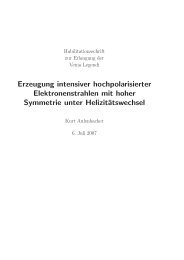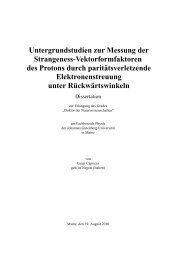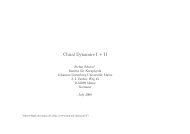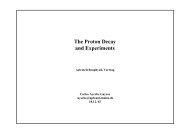EFFECTIVE FIELD THEORIES FOR VECTOR PARTICLES AND ...
EFFECTIVE FIELD THEORIES FOR VECTOR PARTICLES AND ...
EFFECTIVE FIELD THEORIES FOR VECTOR PARTICLES AND ...
Create successful ePaper yourself
Turn your PDF publications into a flip-book with our unique Google optimized e-Paper software.
2.1 quantum chromodynamics 11<br />
There exists an accidental global symmetry due to the numerical<br />
values of the so-called current quark masses, see table 2.1. One can<br />
divide the six quark flavors into the „light“ quarks up, down, strange,<br />
and into the „heavy“ quarks charm, bottom, and top. The splitting scale<br />
of about 1 GeV is justified by the mass of the lightest 2 strongly interacting<br />
particles, i.e. the rho meson with a mass of 770 MeV, and by the scale<br />
of spontaneous symmetry breaking 4πF ≈ 1170 MeV. This leads to a<br />
Lagrangian approximately describing low-energy processes of the strong<br />
interaction<br />
L 0 QCD =<br />
∑ ¯q f iγ µ D µ q f − 1<br />
f =u,d,s<br />
2 Tr(G µνG µν ) , (2.8)<br />
where the light quark masses are set to zero and the heavy quarks are<br />
omitted in comparison to equation (2.1). This approximation is called<br />
chiral limit. By introducing the projection operators,<br />
P R = 1 2 (1 + γ 5) and P L = 1 2 (1 − γ 5) , (2.9)<br />
which project the quark fields q f onto their right-handed q R f<br />
= P R q f and<br />
left-handed q L f<br />
= P L q f components, respectively, the Lagrangian can be<br />
rewritten as<br />
L 0 QCD =<br />
∑ ( ¯q R f iγµ D µ q R f<br />
+ ¯q L f iγµ D µ q L f ) − 1<br />
f =u,d,s<br />
2 Tr(G µνG µν ) . (2.10)<br />
Since the covariant derivative D µ is flavor independent, it follows that<br />
L 0 QCD is invariant under a transformation associated with a U(3) R ×<br />
U(3) L symmetry group in flavor space, which is isomorphic to the symmetry<br />
group SU(3) R × SU(3) L × U(1) V × U(1) A . Here and henceforth,<br />
the basis 3 V = R + L and A = R − L with well-defined parity +1 and −1,<br />
respectively, is used. Naïvely, one would expect 2 × 8 + 2 = 18 conserved<br />
currents according to Noether’s theorem [37]. However, an anomaly in<br />
QCD due to quantum corrections breaks the conservation of the singlet<br />
axial-vector current associated with U(1) A [38, 39, 40], so that QCD in<br />
the chiral limit possesses the symmetry group<br />
SU(3) R × SU(3) L × U(1) V , (2.11)<br />
2 The pseudoscalar pions and kaons are regarded as pseudo-Goldstone bosons and are<br />
therefore treated specially, see section 2.2.<br />
3 Note that this notation is rather symbolic, in some cases a prefactor 1/2 or 1/ √ 2 is<br />
inserted by convention.



